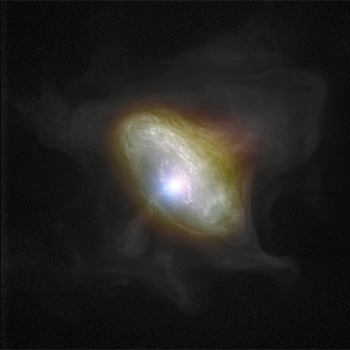
Crab Nebula Sonification, Chandra & NuSTAR
The Crab Nebula, the result of a bright supernova explosion seen by Chinese and other astronomers in the year 1054, is 6,500 light-years from Earth. At its center is a neutron star, a super-dense compact object produced by the supernova. As it rotates at about 30 times per second, its beam of radiation passes over the Earth every rotation, like a cosmic lighthouse.
This sonification of the Crab Nebula contains X-ray data from two NASA telescopes: the Nuclear Spectroscopic Array (NuSTAR) and the Chandra X-ray Observatory. As the scan moves from left to right across the image, the volume of sound is correlated to the brightness of the X-ray data. The pitch is determined in different ways for each telescope. For the NuSTAR data, different musical pitches are mapped to the various regions of color. Red, yellow, purple, blue, and white are assigned to notes beginning with low and ending in higher ones. With the Chandra data, the brightness of the X-rays detected by this telescope dictates the pitch of the sound as well as the volume. Here, the brighter Chandra data creates higher-pitched notes. A bell-type sound indicates the location of the pulsar, the dead core that remains after the star that created the Crab Nebula collapsed.
X-ray: Chandra: NASA/CXC/SAO; NuSTAR: NASA/JPL/Caltech/NuStar; Sonification: NASA/CXC/SAO/K.Arcand, SYSTEM Sounds (M. Russo, A. Santaguida)
The Chandra sonifications were led by the Chandra X-ray Center (CXC), with input from NASA's Universe of Learning. The sustained collaboration was driven by visualization scientist Dr. Kimberly Arcand (CXC), astrophysicist Dr. Matt Russo and musician Andrew Santaguida (both of the SYSTEM Sounds project). For other sonifications, please see their linked pages.
cxcpub@cfa.harvard.edu
617-496-7941
60 Garden Street,
Cambridge, MA 02138 USA
Art Direction/Design: Kristin DiVona
Web Developers: Khajag Mgrdichian
& Kelly T.S. Williamson
Chandra X-ray Center, Operated for NASA by the Smithsonian Astrophysical Observatory. This site was developed with funding from NASA under contract NAS8-03060 | Privacy | Accessibility
Additional support from NASA's Universe of Learning (UoL). UoL materials are based upon work supported by NASA under award number NNX16AC65A to the Space
Telescope Science Institute, working in partnership with Caltech/IPAC, Jet Propulsion Laboratory, and Smithsonian Astrophysical Observatory.



